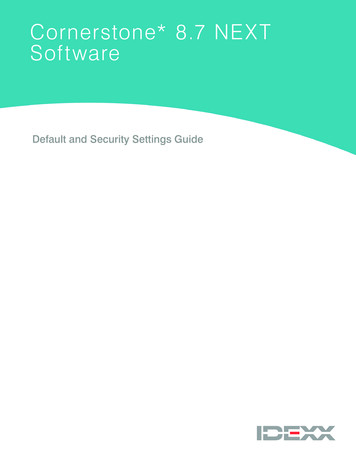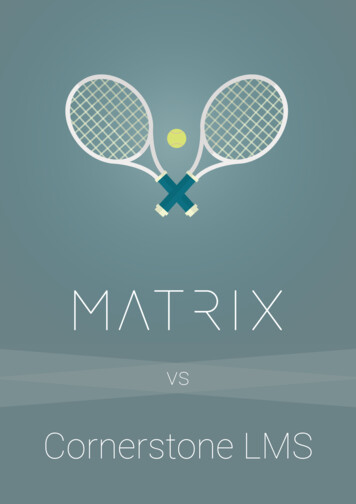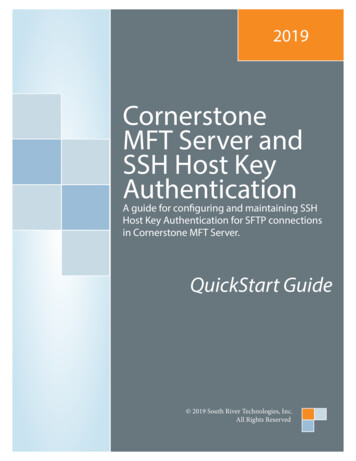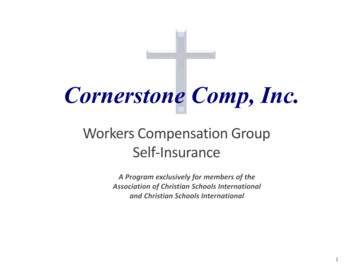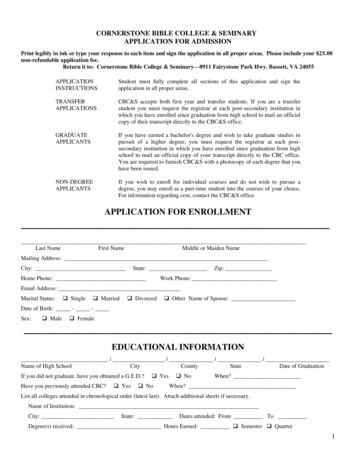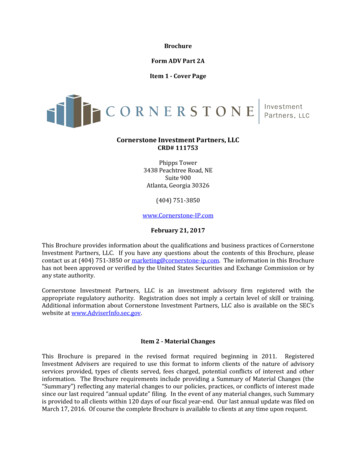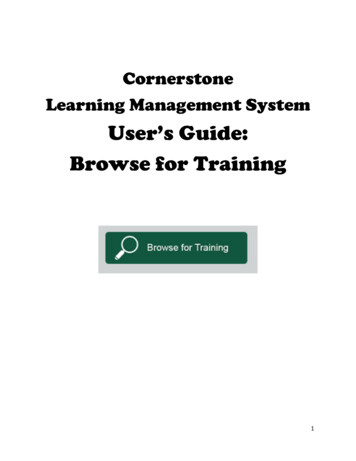
Transcription
Customer outcomes: The cornerstone of exponential growth Table of ContentsCustomer outcomes: The cornerstoneof exponential growthHow pivoting to a customer outcome-centricstrategy accelerates growth and increases customer lifetimevalue0
Customer outcomes: The cornerstone of exponential growth Table of ContentsTable of ContentsTable of Contents1Customer Outcomes: Recognized by All, Realized by Few2The Integrated Customer Outcomes Acceleration System4Elements of the Integrated Customer OutcomesAcceleration ences131
Customer outcomes: The cornerstone of exponential growth Customer Outcomes: Recognized by All, Realized by FewCustomer Outcomes:Recognized by All,Realized by FewThe increased growth and adoption ofcloud-based technologies has shiftedexpectations for the business-to-business(B2B) customer experience. Customersare shifting from evaluating technologyproviders solely on the basis of productfeatures to a more nuanced criteria ofhow the provider’s product can enablethem to maximize their businessoutcomes. As cloud technologies and asa-service subscription model’s lowerbarriers to switching providers,1technology provider must differentiatebased on experience to encourage2customers to remain loyal to theirproducts and services and focus on howtheir product and service offerings canhelp customers realize intended businessoutcomes. This will eventually enabletechnology providers to further expandtheir footprint with customers andconvert them into loyal advocates andambassadors of the provider’s solutions.Delivering on a premier customerexperience requires collaborativeorchestration across a number offunctions, and companies that aresuccessful at this have been able to drivehigher retention and growth in theircustomer base by enabling customers torealize their intended business outcomes.More and more companies, in fact, arestarting to monitor net dollar retention(NDR), which measures the percentage ofrevenue retained from existing customersover time and serves as a key indicator ofcustomer lifetime value and the ability todeliver on customer outcomes. Themarket, too, has begun to track—andreward—companies with strong NDR inrecent years, as illustrated by a strong
Customer outcomes: The cornerstone of exponential growth Customer Outcomes: Recognized by All, Realized by Fewmarket correlation between high NDRand company valuation.2purchase and implementation, andultimately through to value realization.A 2021 Deloitte Study on B2B customerexpectation gaps found that B2B buyersare 34% more likely to buy and 32% morelikely to renew a contract with leadingsuppliers that master customerexperience, though the meaning of“mastering customer experience” ischanging rapidly.3 Swift resolution ofissues is no longer enough. Enterprisecustomers are increasingly looking attechnology companies not just as solutionproviders, but as partners who will helpthem realize value throughout the lifecycle, from initial exploration, throughIn response, most technology companieshave invested in customer successcapabilities to proactively supportcustomers to maximize usage and realizetheir desired outcomes. Becausecustomer success orchestrates valueacross the customer journey, this requiresthat all functions are aligned and workingtoward this objective. Thus, this hasincreased the need for close collaborationbetween customer success and otherfunctions, such as product, marketing,sales, services, and support. However,most organizations are far from achievingtheir desired level of focus on customercentricity. A 2021 Deloitte study of chiefcustomer officers (CCOs) in thetechnology industry found that 88% ofCCOs strongly agree that a focus oncustomer outcomes is the next businessmodel evolution.4 However, only 15%stated that they have the right level ofmaturity to deliver on this strategy. Thisvision-execution gap aligns with ourcustomer success study, where we foundthat while 90% of enterprise customersdiscuss their desired business outcomeswith their technology providers, morethan 50% note that the solutions, onceimplemented, do not deliver fully onthese outcomes.So, the message is clear—customers areno longer happy hearing, “We will helpand guide you toward success.” Theyshould be able to trust that success willbe delivered, that value will be realized,and that the experience will exceedexpectations. However, guaranteeingsuccess is not something that can be doneby a standalone customer successfunction. It involves orienting the entireorganization toward outcomes, and allstakeholders, processes, tools, andenablers should play their part inunderstanding the customer experienceand translating customer insights intoaction to ensure that the customerachieves the outcome desired.about translating those insightsinto action?While it is evident that demonstratingtangible results with respect to customeroutcomes is the way forward, we arefaced with the obvious questions: How dowe do this? What is the secret sauce? Is itsimply about working with the customerthroughout the life cycle? Is it aboutstrengthening internal functions to betterserve customers? Is it about innovativebusiness models, or cutting-edgetechnology and data-driven insights? Is itThe answer: a bit of all of this and more.3This article, the first in a series, exploresthe integrated strategy and operatingsystem that must be in place to deliver oncustomer outcomes and supportcustomers in value realization.Subsequent articles will delve into eacharea of the operating system in greaterdetail, beginning with a second articlefocused on operationalizing value deliveryalong the journey.
Customer outcomes: The cornerstone of exponential growth The Integrated Customer Outcomes Acceleration SystemThe Integrated CustomerOutcomes AccelerationSystemOur market experience, research, and data have demonstrated patterns of how leading organizations are increasing the focus oncustomer outcome delivery. The following framework can be thought of as an integrated system to close the vision-execution gapand define elements required to craft and operationalize a customer outcomes strategy, integrating all key functions across theorganization. This integrated system can be visualized as a “customer outcomes galaxy,” with customer outcomes at the centeraround which everything else revolves:To achieve a customer outcome orientation, a provider shoulddeliberately construct an organizational system that addressesthe following questions:Customer Outcomes Company Impact41.Value: What are the customer’s desired outcomes?2.Customer journey: How will the customer’s journey beproactively orchestrated toward outcomes, at each step?3.Collaboration and experience: How will internal andexternal stakeholders come together to translate customerinsights into action and deliver outcomes?4.Enablement: What foundational systems, process, talentand operational models must be put in place to enable anoutcome-based approach?5.Company impact: What are the dimensions of value that theprovider—in return—can capture for themselves?
Customer outcomes: The cornerstone of exponential growth Elements of the Integrated Customer Outcomes AccelerationSystemElements of theIntegrated CustomerOutcomes AccelerationSystem1. Value: What are the customer’s desired outcomes?The first step in developing an integratedsystem for customer outcome delivery isto define the customer’s desiredoutcomes and how success will bemeasured—particularly through the lensof value delivered to the customer. A2021 Deloitte study of CCOs in thetechnology industry6 validates that mostorganizations’ “customer health score”components are defined through aninside-out lens (e.g., growth of anaccount), rather than an outside-in lens(e.g., time between onboarding and firstvalue delivered to the customer). Ascompanies transition to becomingoutcome-centric, the value equation mustbecome more balanced to include valuedelivered to the customer and measuredthrough a customer lens. This includesefficacy of the product, experience duringinteractions with the provider, andtangible financial benefits provided by thesolution. Therefore, it is necessary that allfunctions within the solution provider’sorganization are clearly aligned on thedefinition and scope of value. Thisdefinition should also be aligned withcustomer’s expectations since themeaning of value may varyacross customers.5In Deloitte’s 2020 customer successmarket study, enterprise customersvalidated that value has three primarydimensions: the value add to a customer’sbusiness, the efficacy and performance ofthe solution, and the customer’sexperience with the product andservices.7 Thus, broad categories of“value” are business value, performancevalue, and experience value. Performance value—Value derivedfrom the solution in terms of qualityof the product, utility of features,solution compatibility, user interface,and uninterrupted usage withoutissues, errors, or bugs. In fact, 85%customers increase spending withtheir providers when their solutionfeedback is incorporated.8 Business value—Value derived fromthe solution provider’s offerings thathelp customers achieve quantifiablebusiness outcomes (e.g., decreasetotal cost of ownership, increaserevenue, improve operationalefficiency, reduce technology debt),and justify their investment inthe solution. Experience value—Value derived fromthe quality of experience delivered,ease of doing business, and depth ofrelationship established during varioustouchpoints and interactions (bothpre- and post-sales). In fact, thenumber of customers who advocatetheir provider’s solutions more thandoubles when there are regularbusiness reviews in place throughouttheir experience with the provider.9In addition to delivering on value throughthe lens of customer experience,providers must also think about valuethrough the lens of the employee andpartner experiences, as well. Thisrelentless, collaborative focus on theoutcome-driven experience ecosystem isrequired for companies to stand outamidst the competition, and in fact,companies that focus on employee andpartner experience are twice as likely tooutperform their peers.10
Customer outcomes: The cornerstone of exponential growth Elements of the Integrated Customer Outcomes Acceleration System2. How will the customer’s journey be proactively orchestrated toward outcomes, at eachstep?To deliver a differentiated and outcomedriven experience, it is essential to putthe customer at the center of thecustomer journey and correspondingcustomer engagement model. Leadingsolution providers apply human-centricdesign thinking to reimagine and craftcustomer journeys that reflect thecustomer’s desired experience,personalized needs, and expectations ofvalue along each journey stage. Thisbegins by identifying individual customerpersonas, including their uniquepreferences and expectations. Thesepersona profiles are combined with theneeds defined across the three valuedimensions of performance value,business value, and experience value, toprovide distinct insights into eachpersona’s definition of success.Armed with these persona-basedcustomer insights, providers must thendefine an end-to-end customer journeythat maps key interaction points andmoments of value realization throughoutthe entire customer life cycle. The journeydesign should also incorporate customerengagement preferences, as today’scustomer expects flexible and consistentengagement alternatives alongthe journey: Understand me: Enable personalizedand customized interactions andengagement based on the customer’sunique situation and individual needs Enable me: Create robust self-servicecapabilities that unlock customer6access to information, tools, andresources that are tailored to theirbusiness needs Work for me: Utilize technology,automation, and cognitive insights toprovide proactive, predictive, andpersonalized solutions Empower me: Operationalize acustomer-first mindset through allinteractions with a focus on individualempowerment through insights, data,and feedback mechanismsThe next step in customer journey designis to identify critical engagement points(CEPs) along the customer journey, thatreflect high-impact points of customerinteraction, critical adoption milestones,specific customer outcomes, and points ofvalue realization along the customerjourney. For each CEP, providers shouldarticulate the customer’s definition ofsuccess, identify cross-functional teamsinvolved, and define measurementcriteria to track, analyze, and improve theeffectiveness of each CEP over time.By understanding these moments thatmatter, solution providers can alignotherwise- siloed functional teamsaround a shared purpose of delivering adefined customer outcome. Here it is alsocritical to incorporate the desiredemployee experience and define howvarious cross-functional teams willleverage systems, tools, and data tomaintain internal alignment and helporchestrate the customer to achieve thedesired outcome.Mapping out the customer journey fromboth the perspective of the customer andtheir objectives, as well as the providerand their responsibilities, helps to identifywhether or not the provider is performingthe right activities—and equipped withthe necessary capabilities—to exceedcustomer expectations.Solution providers next must identify thenecessary operational, financial, andcustomer sentiment data-capturingmechanisms to capture holisticinformation about the customer’sexperience at each critical engagementpoint. Many organizations are evolvingtraditional Voice of the Customer (VOC)activities toward more comprehensiveexperience management programs thatincorporate journey-based listening—ingesting customer data from multiplesources, aggregating that data, andgenerating insights.The final step is to then ensure that aclosed feedback loop is in place to routecustomer insights to the appropriatefunction or resource to take action.Establishing this insights-to-action motionis imperative to ensuring thatorganizations take action on theproliferation of data that can be capturedacross the customer journey to deliver anenhanced, personalized, and improvedcustomer experience.
Customer outcomes: The cornerstone of exponential growth Elements of the Integrated Customer Outcomes Acceleration System3. Collaboration and experience: How will internal and external stakeholders come togetherto translate customer insights into action and deliver outcomes?Once a common journey has beenestablished, the next step is to identifythe specific internal stakeholder groupsand roles that will collaborate to deliveron the customer experience. Every stageof the life cycle has various subfunctionsshouldering the responsibility of assignedtasks that are relevant for the stage, whileworking toward one common objective.In many organizations, these subfunctionscan sit closely together and often reportto the same leader. This requires all theteams to work collaboratively towardclosing the “customer value loop” acrossall the above life cycle stages, instead ofworking in silos. For example: Product: Products must beinstrumented to capture necessarycustomer insights in order for postsales functions to validate whether ornot the customer is realizing value. Inturn, insights captured can be passed7back to the product teams to prioritizefeatures and conduct sprint-baseddevelopment based on specificcustomer needs—a more agileapproach. Marketing: This is typically the firstchannel through which a customerforms an impression about theprovider. Marketing teams must havean understanding of value to bedelivered to the customer and canbenefit from a closed feedback loopfrom post-sales functions toincorporate value realization insightsinto future campaigns. Sales: More than discussing productfeatures, sales teams must be able toarticulate the performance,experience, and business value thatcan be derived from the provider’ssolution(s). 90% of customers arelooking for customer success supportin the pre-sales’ stages, suggesting anopportunity for sales and customersuccess to have a more collaborativemotion upfront to support valuearticulation and ensure a seamlesshand-off with mutual understandingof the customer’s desired outcomes.11 Partners: With the majority ofrevenue derived from channelpartners must be enabled by providerssuch that customer outcomes remainat the forefront of the conversation.12More and more organizations areinvesting in partner-driven customersuccess capabilities to ensure thatcustomer experience is consistent,and outcomes are not compromised. Customer experience: The customerexperience function oversees the endto-end relationship with the customeralong their journey with the solutionprovider. That includes identifyingmanaging the critical engagementpoints with a customer, or those
Customer outcomes: The cornerstone of exponential growth Elements of the Integrated Customer Outcomes Acceleration Systemmoments when the customer formsan impression of their experience withthe business. Many VOC programs arenested within the customerexperience function and focus onensuring that the right listeningprograms are in place (e.g., customersurveys or product, financial, andoperational data) to collect customerinsights and ensure a closed feedbackloop with other internal, crossfunctional teams. Customer success: Customer successfocuses on proactive orchestration ofcustomer outcome delivery, ensuringsuccessful adoption, usage, and valuerealization, mitigating account risk,and driving toward renewal andexpansion. This naturally requiresorchestration across post-salesfunctions to monitor customer healthand engage the appropriate resourcesto support outcome delivery and riskmitigation as required. Services and support: Typicallyresponsible for post-sale delivery,operations, and issue resolution,services and support functions play adirect role in supporting customers torealize their desired objectives. Theyprovide expertise to monitor progresstoward adoption and consumptionand can identify opportunities toincrease effectiveness and, ultimately,value delivered to the customer.Services can include professionalservices, field services, managedservices, and learning services.Overcoming the collaboration challengesinvolves a unified approach, where allinternal and external stakeholders in theprovider’s organization work together,with well understood role boundaries,metrics, and guidelines in place to avoidconflict and redundancy, while utilizingsynergies across the teams.4. Enablement: What foundational systems, process, talent and operational models must beput in place to enable an outcome-based approach?While various functions and roles cancollaborate to maximize value across thedifferent customer life cycle stages, anumber of enablement mechanisms mustbe in place to achieve this. These8enablement mechanisms should spantalent and culture, data and cognitiveinsights, operations and process, tools,and platforms, and offers andmonetization.a. Offerings and MonetizationThe first enabler in the outcomebased approach is the businessand monetization model of the
Customer outcomes: The cornerstone of exponential growth Elements of the Integrated Customer Outcomes Acceleration Systemservice offerings used as thevehicles to deliver customeroutcomes. While providers offersome services free of cost, othersoffer services through a “for-fee”model through core subscriptionmodels, packaged in tieredservice bundles, or as standaloneofferings. However, organizationsthat offer standalone serviceshave a more difficult time sellingthose services, as they typicallyhave lower margin and do notconvey the value of a holisticcustomer outcomes approach. Incontrast, the next step in theevolution of offerings andmonetization models is to explorebundling services into outcomecentric offerings, such as promiseof uptime or guaranteedperformance levels—yet anotherstep in the journey toward a morecustomer-centric and outcomefocused approach.b. Talent and CultureAt the heart of driving customeroutcomes is establishing acustomer-centric culture andtalent base across theorganization. Organizations arebeginning to elevate customeroutcomes as a focal point, with adedicated leader to encouragethis focus and drive a consistentcustomer experience. Anemerging practice amongtechnology companies is theintegration of services teams—including customer success,technical support, professionalservices, managed services, fieldservices, and learning services—under the role of the CCO orequivalent to further drive thisconsistency. Outside of their9direct influence, CCOs also play acritical role in influencing therules of engagement with sales,marketing, product, andengineering. In fact, leaders whoagree that their sales andcustomer success teams are seenequal peers are more than twiceas likely to agree that they areorganizationally mature enoughto drive customer outcomes.13Finally, companies are beginningto adopt outcome-focusedmetrics as a way to incentivizecross-functional teams, includingintroducing consumption-focusedmetrics as incentives for salesand services teams to increasethe focus on customeroutcomes delivery.c. Data and Cognitive InsightsA proliferation of data isgenerated at every stage of thelife cycle, and a customer-focusedsolution provider will effectivelycollect, store, secure, analyze, anduse the data to help customersachieve their desired outcomes.Increasingly, companies arebeginning to leverage data asproactive and predictiveindicators of customer experienceand propensity to churn. Thismanifests itself through earlywarning systems or calls to actionthat can notify the solutionprovider of specific customerbehaviors. For example, if acustomer does not reach apredefined threshold in terms ofnumber of licenses activated, thiscould notify a customer successmanager that adoption levels arelow, increasing the risk forrenewal or expansion.Furthermore, companies arebeginning to invest in morerobust VOC programs, focused oncombining traditional indicatorsof customer experience (e.g., NetPromoter Score (NPS), CustomerSatisfaction (CSAT)) with productand operational data for a morecomprehensive view of outcomedelivery that helps create a casefor action.14d. Operations and ProcessesFrom an operational perspective,clear processes and hand-offsmust be in place to drive africtionless experience for theend-customer. However, in arecent Deloitte study, only 24% oforganizations strongly agreed thattheir company faces no “crossfunctional friction” in drivingcustomer outcomes.15 Manyorganizations are beginning totake steps to evolve their internalprocesses, including increasinginformation sharing acrossfunctions to increasecollaboration, tailoring incentivesto promote cross-teamcollaboration, and experimentingwith new operating models thatallow for more dynamic teamingand engagement. A leadingpractice across many technologyorganizations is enabling aninsights-to-action motion,ensuring the right processes are inplace to route customer insightsto the appropriate party withenough lead time for the party totake action in tangible ways toimprove the customer experience.e. Tools and PlatformsIn addition to having the rightprocesses in place, organizations
Customer outcomes: The cornerstone of exponential growth Elements of the Integrated Customer Outcomes Acceleration Systemmust also have the right tools andplatforms required to facilitatecross-functional collaboration.Investing in a comprehensivecustomer outcomes technologystack can help ensure that theright data collection,consolidation, analytics, andreporting platforms are in placeand woven around customerexperience and outcomes. Thishas become increasinglyimportant as customer outcomesorganizations start to shift to a“digital-first,” mindset.Technology is being leveraged todrive digital customerinterventions to provide thecustomer with guidance andsupport or drive the customer toa certain action. As companieslook to scale their customersoutcomes capabilities, technologyis being positioned as the keystrategic enabler for customeroutcomes across all segments,with human touch reserved forcritical accounts and engagementpoints. A future article willexplore the topic of the need for acomprehensive customeroutcomes technology stack ingreater detail.5. Company Impact: What are the dimensions of value that the provider—in return—cancapture for themselves?While customer outcomes sit at thecenter of the galaxy, around whicheverything else revolves, acomprehensive outcome-based approachmust ensure proportionate valuedelivered for the customer and for theenterprise. If an organization isorchestrated in the right way to maximizecustomer outcome delivery, it shouldultimately impact the company positively.It is imperative for any CCO to define,measure, and report on the valuedelivered to the enterprise to helpmeasure the return on investment forenabling customer outcomes and elevatethe impact of customer-centricity to theboard room agenda. This value realizationis beginning to garner more attentionfrom executive leadership, with 58% ofCCOs now reporting directly to the CEO.16Furthermore, out of a set of surveyedcompanies, 79% agree that theconversation with the executiveleadership team has shift from just profitand revenue toward customer value, asthis, in turn, has proven itself to drive10longer-term financial benefits for theprovider.17With the growing focus on customeroutcomes, this purpose has becomeclearly defined in terms of metrics,including the aforementioned customerlifetime value and NDR. Additionally,companies embracing customer successsee more than 10% higher upsell andcross-sell revenue and more than 20%higher annual recurring revenue.18 As theoutcome’s galaxy begins to function,companies start to realize impact acrossthree parameters: Economic value: Value realized by theprovider for delivering offerings thathave a positive financial impact on thecompany’s operations, as measuredby new revenue growth, customerlifetime value, cost to serve, and NDR Brand advocacy: Value realized by theprovider for delivering experiencesthat lead to increased customeradvocacy, as measured by number ofreferrals or references, customeradvocacy activities, and customersatisfaction (e.g., NPS and CSAT) Market Eminence: Value realized bythe provider in the form of elevationin market perception and recognitionas an industry leader by majoranalysts and peers, including analystratings, analyst mentions, and CCOindustry recognitionDeveloping the underlying components ofthe customer outcomes galaxy shouldonly be pursued following the definitionof a clear investment case. This shouldarticulate the expected return oninvestment and quantitative case forchange. This articulation will support thecase for elevating the focus on customeroutcomes, and the economics behind theinvestment will resonate with the crossfunctional leadership required to supportthe organization on this journey.
Customer outcomes: The cornerstone of exponential growth ConclusionConclusionThe previous decade witnessed adisruption in terms of the evolution ofpriorities to a more customer-centricapproach. However, this evolutioncontinues, and the approach must now betailored toward a focus on outcomedelivery to the customer. This will ensurethat customers achieve their desiredbusiness outcomes using a provider’sproducts, services, and solutions.Eventually, this helps the provider retainand grow their customer pool, whilecontinuously multiplying value andimproving key metrics, includingcustomer lifetime value and NDR.While the discipline of customersuccess—and now customer outcomes—emerged from the Technology industryand software-as-a-service in particular,we are starting to see the evolution ofcustomer outcomes into new paradigms,including health care, industrial products,telecommunications, payments, andmore. This is largely due to the rise ofInternet of Things, the proliferation ofcustomer data, and the ongoing shifttoward everything-as-a-service business11models. Characteristics of companies thatmay be candidates for a more intensefocus on customer outcomes are:Navigating this shift toward customeroutcomes will require a deep-dive intofollowing questions: An ecosystem of products, services,and/or solutions Products with a high level ofcomplexity that require heavyinvolvement on behalf of the providerto manage and achieve full value forthe customer Business models that derive valuefrom customers as a function of howmuch and how well the end customeruses the product or service Business models that necessitatemeasuring performance as a functionof product onboarding, consumption,expansion, adoption, and/or renewals Customers who benefit from receivinggreater insights with the addition ofeach product that they adopt andseamlessly integrate Customers who have high switchingpower among providers ofthese solutions How will customer value be defined? What the customer needs are alongthe journey and how value canbe delivered? How can stakeholders come togetherto translate customer insights intoaction and drive an experiencefocused on outcomes? What systems, processes, andoperational models need to be inplace to support? How the provider will—in return—capture value for themselves?Subsequent articles will delve deeper intovarious components of the customeroutcomes galaxy, which will continue tobe updated over time as we continue towitness evolving practices and prioritiesin the market.
Customer outcomes: The cornerstone of exponential growth AuthorsAuthorsGopal SrinivasanPrincipalDeloitte Consulting LLPgosrinivasan@deloitte.comAftab KhannaSenior ManagerDeloitte Consulting LLPafkhanna@deloitte.comDeepak SharmaManaging DirectorDeloitte Consulting LLPdeepaksharma8@deloitte.comLindsey CashManagerDeloitte Consulting LLPlcash@deloitte.comMarybeth D’SouzaPrincipalDeloitte Consulting LLPmardsouza@deloitte.comAnand Mohan
starting to monitor net dollar retention (NDR), which measures the percentage of revenue retained from existing customers over time and serves as a key indicator of customer lifetime value and the ability to deliver on customer outcomes. The market, too, has begun to track—and reward—companies with strong NDR in


